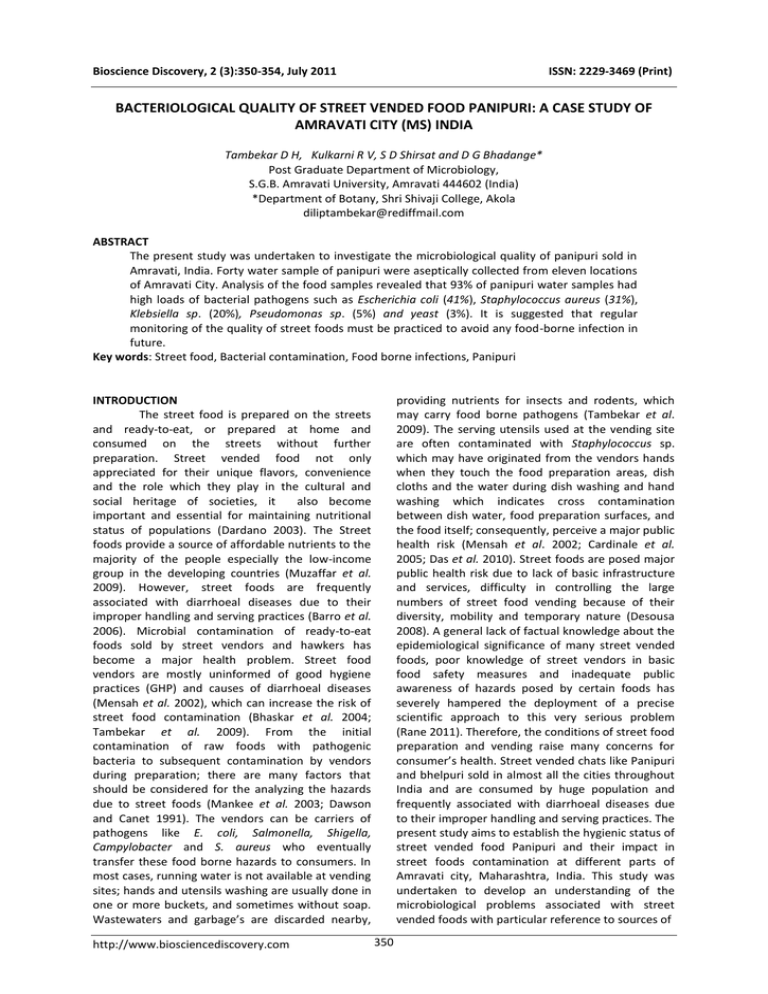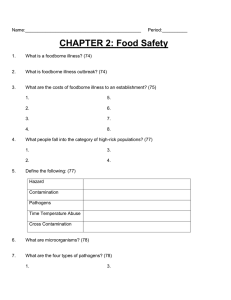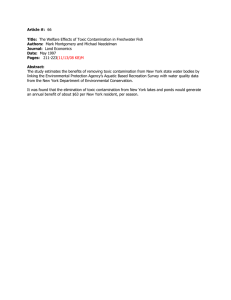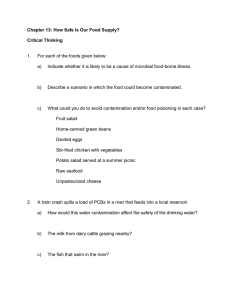bacteriological quality of street vended food panipuri
advertisement

Bioscience Discovery, 2 (3):350-354, July 2011 ISSN: 2229-3469 (Print) BACTERIOLOGICAL QUALITY OF STREET VENDED FOOD PANIPURI: A CASE STUDY OF AMRAVATI CITY (MS) INDIA Tambekar D H, Kulkarni R V, S D Shirsat and D G Bhadange* Post Graduate Department of Microbiology, S.G.B. Amravati University, Amravati 444602 (India) *Department of Botany, Shri Shivaji College, Akola diliptambekar@rediffmail.com ABSTRACT The present study was undertaken to investigate the microbiological quality of panipuri sold in Amravati, India. Forty water sample of panipuri were aseptically collected from eleven locations of Amravati City. Analysis of the food samples revealed that 93% of panipuri water samples had high loads of bacterial pathogens such as Escherichia coli (41%), Staphylococcus aureus (31%), Klebsiella sp. (20%), Pseudomonas sp. (5%) and yeast (3%). It is suggested that regular monitoring of the quality of street foods must be practiced to avoid any food-borne infection in future. Key words: Street food, Bacterial contamination, Food borne infections, Panipuri INTRODUCTION The street food is prepared on the streets and ready-to-eat, or prepared at home and consumed on the streets without further preparation. Street vended food not only appreciated for their unique flavors, convenience and the role which they play in the cultural and social heritage of societies, it also become important and essential for maintaining nutritional status of populations (Dardano 2003). The Street foods provide a source of affordable nutrients to the majority of the people especially the low-income group in the developing countries (Muzaffar et al. 2009). However, street foods are frequently associated with diarrhoeal diseases due to their improper handling and serving practices (Barro et al. 2006). Microbial contamination of ready-to-eat foods sold by street vendors and hawkers has become a major health problem. Street food vendors are mostly uninformed of good hygiene practices (GHP) and causes of diarrhoeal diseases (Mensah et al. 2002), which can increase the risk of street food contamination (Bhaskar et al. 2004; Tambekar et al. 2009). From the initial contamination of raw foods with pathogenic bacteria to subsequent contamination by vendors during preparation; there are many factors that should be considered for the analyzing the hazards due to street foods (Mankee et al. 2003; Dawson and Canet 1991). The vendors can be carriers of pathogens like E. coli, Salmonella, Shigella, Campylobacter and S. aureus who eventually transfer these food borne hazards to consumers. In most cases, running water is not available at vending sites; hands and utensils washing are usually done in one or more buckets, and sometimes without soap. Wastewaters and garbage’s are discarded nearby, http://www.biosciencediscovery.com providing nutrients for insects and rodents, which may carry food borne pathogens (Tambekar et al. 2009). The serving utensils used at the vending site are often contaminated with Staphylococcus sp. which may have originated from the vendors hands when they touch the food preparation areas, dish cloths and the water during dish washing and hand washing which indicates cross contamination between dish water, food preparation surfaces, and the food itself; consequently, perceive a major public health risk (Mensah et al. 2002; Cardinale et al. 2005; Das et al. 2010). Street foods are posed major public health risk due to lack of basic infrastructure and services, difficulty in controlling the large numbers of street food vending because of their diversity, mobility and temporary nature (Desousa 2008). A general lack of factual knowledge about the epidemiological significance of many street vended foods, poor knowledge of street vendors in basic food safety measures and inadequate public awareness of hazards posed by certain foods has severely hampered the deployment of a precise scientific approach to this very serious problem (Rane 2011). Therefore, the conditions of street food preparation and vending raise many concerns for consumer’s health. Street vended chats like Panipuri and bhelpuri sold in almost all the cities throughout India and are consumed by huge population and frequently associated with diarrhoeal diseases due to their improper handling and serving practices. The present study aims to establish the hygienic status of street vended food Panipuri and their impact in street foods contamination at different parts of Amravati city, Maharashtra, India. This study was undertaken to develop an understanding of the microbiological problems associated with street vended foods with particular reference to sources of 350 Tambekar et al. ISSN: 2231-024X (Online) concern to everybody. Microbial contamination of ready-to-eat foods and beverages sold by street vendors and hawkers has become a global health problem. In developing countries, fruit juices, drinks, meals and snacks sold by street-food vendors are widely consumed by millions of people. There are some reports of food borne illness associated with the consumption of contaminated street vended food like panipuri. Street vended food like panipuri sold in almost all cities throughout India consumed by huge population. The present study was undertaken to investigate the microbiological quality of panipuri sold in Amravati, India. Food hawkers in India are generally unaware of food regulations and have no training in food-related matters. They also lack supportive services such as water supply of adequate quality and rubbish disposal systems, which hamper their ability to provide safe food (Titarmare et al. 2009). A total of forty water samples of Panipuri were analyzed for presence of bacterial pathogens. The study revealed 93% pathogenic bacterial contamination, majority of them contamination with Escherichia coli, Staphylococcus aureus, Klebsiella sp., Pseudomonas sp., and Yeast indicating poor bacteriological quality of the Panipuri. Several authors have observed those bacteria from dirty dish washing waters and other sources can adhere to utensil surfaces and constitute a risk for contamination during food vending (Bhaskar et al. 2004; Mosupye et al. 2000). Defective personal hygiene can facilitate the transmission of these pathogenic bacteria found in environment and on people’s hands via food to humans (Tambekar et al. 2008; Mensah et al. 2002). Twenty-nine panipuri samples were collected from crowed vendors and 11 from non–crowded area. The samples collected from crowded area were more contaminated than noncrowded area. The percentage of contamination was 73% in crowded areas and 27% in non-crowded area. The percentage of contamination of samples which were collected in summer was 60% and 40% in post winter (Fig 1). The personal hygiene of vendor or worker is important in hygienic venting of panipuri and it was found that poor personal hygiene contaminate the food item more. At the same time dirty cloths and hands increases the degree of contamination (65%) as compared to clean clothes (35% contamination). More the workers more are the chances of handling of utensils which may leads to higher degree of bacterial contamination. The vending site also reflect the contamination in street food, more the unhygienic condition or surroundings of area more degree of bacterial contaminations (Table 1). risk and to identify the behavior and practices that may be hazardous. MATERIALS AND METHODS Study site and samples collection: Bacteriological investigations of Panipuri in Amravati city were performed during Feb-April 2011. The study was conducted in the major streets and markets of Amravati. There was approximately fourty vending sites. Samples were collected during visits to the sites. Vending sites hygiene and salubrious status were determined by use of structured interview and through observations. A total of 40 Panipuri water samples were collected from selected vending sites in sterile containers and analyzed after procurement. Sample analysis: For analysis 1 ml Panipuri water sample was inoculated in to Mac-Conkey broth and 0 incubated for 12-16 h at 37 C. The microbial growth was observed as turbidity in broth, and then sub cultured on the Cysteine Lactose Electrolyte Deficient agar (CLED) and incubated at 37 C for 24 hrs. After incubations, suspected colonies were identified based on their morphological, physiological and biochemical features using microscopic observation, standard biochemical methods and cultural characteristics on CLED such as yellow colored colonies of lactose fermenting E.coli, greenish blue or blue colonies of Ps. aeruginosa, mucoidal yellow to whitish blue colonies of Klebsiella spp. and deep opaque colonies of S. aureus (HiMedia manual 2003). Data handling and analysis: Along with collection and bacteriological analysis of Panipuri water, through field notes, personally administered interviews and a semi-structured questionnaire of randomly selected street food vendors were surveyed. Data on vital statistics was collected using interview schedules and observation, 40 randomly selected street food vendors in Amravati city were recruited into the study which had given their approval and the vendors were assured total confidentiality. Data extracted included season of sampling, site of shop, hygienic status of vendor, their servants, number of workers and their cloths type, hygienic condition of vending site, age, sex, educational status, initial income, knowledge of food vending, place of food preparation etc were recorded and analyzed by SPSS statistical package. RESULTS AND DISCUSSION Hygienic quality of street food vending has become an important public health issue and a great http://www.biosciencediscovery.com 351 Bioscience Discovery, 2 (3): 350-354, July 2011 ISSN: 2229-3469 (Print) Fig. 1: Percent Pathogenic Bacterial contamination in Panipuri 100% 93% 87% 80% 73% 65% 60% 60% 60% 60% 40% 40% 40% 35% 40% 27% 20% 10% 7% 2% Poor Fair Clean Dirty Poor Fair Three Two One Summer Post Winter Non Crowded Crowded Non-Contaminated Contaminated 0% Table 1 : Prominent Bacterial pathogen isolated from various water sample of Panipuri Ps.aeruginos E. coli S. aureus Klebsiella spp. Yeast a Number Number Number Number Number of % % of % of % of % of isolates isolates isolates isolates isolates Crowded 26 38% 20 29% 5 7% 16 24% 2 2% Site of shop Non Crowded 4 66% 1 17% 0 0 1 17% 0 0 Post Winter 14 35% 12 32% 4 10% 7 18% 2 5% Season of collection Summer 18 40% 14 31% 1 2% 13 27% 0 0 Number of workers Personal Hygiene of Vendor Cloths of Worker Hygienic Condition Vending Site One Two 20 4 38% 31% 15 4 28% 31% 2 1 3% 7% 15 4 28% 31% 2 0 3% 0 Three Clean Fair 1 0 13 50% 0 34% 1 1 11 50% 33% 29% 0 1 2 0 33% 5% 0 1 12 0 33% 32% 0 0 0 0 0 0 Poor 10 40% 8 32% 0 0 7 28% 0 0 Dirty 14 38% 12 33% 1 2% 8 22% 2 5% Clean 8 25% 10 31% 2 6% 12 38% 0 0 Fair 12 31% 13 32% 2 5% 13 32% 0 0 Poor 10 33% 9 31% 1 3% 8 27% 2 6% http://www.biosciencediscovery.com 352 Tambekar et al. ISSN: 2231-024X (Online) Overall study indicated that 93% panipuri sample were contaminated with variety of pathogenic bacterial contaminations Many people have worked on the fact that Panipuri is contaminated with different bacterial pathogens because of various sources like improper handling of street foods, washing of utensils, dish cloths, stalls are at crowded place and movable stalls. E. coli and other coliform bacteria could be due to inadequate hand washing by food workers and the absence of good manufacturing practices. The occurrence of P. aeruginosa might be due to improper personal hygiene, unhygienic surroundings, vehicular transmission, and sewage. The presence of S. aureus was severe contamination through handling (Tambekar et al. 2007). The water sample of Panipuri from different areas of Amravati has different percentage of pathogens. Crowded areas have more percentage of pathogens than noncrowded areas (Table 1). In addition, there is potential health risks associated with initial contamination of foods by pathogenic bacteria as well as subsequent contamination by vendors during preparation, handling, and cross contamination (Mosupye and Van Holy 2000). From all above discussion it was concluded that chatpata water of panipuri was contaminated with E. coli, S. aureus, K. pneumoniae, P. aeruginosa, yeast which cause various food borne infections. CONCLUSION Panipuri is very popular street food which is consumed by large amount of population of different age groups. Panipuri is very tasty, cheap in cost and readily available and hence people like to eat panipuri on large scale. For the contamination of street food, personal hygiene of vendor is also responsible. Vendors touch the floor, wash the utensils most of the time without using soap, handling of dish cloths and after all they touch food without glows for preparing and serving water without washing the hands, this may lead to cross contamination of bacterial pathogens. All the steps involved from preparation to serving of foods and food ingredients to the consumer must be bacteriologically evaluated. In the present study, the bacteriological quality of water of panipuri found to be contaminated with different bacterial pathogens like E. coli, S. aureus, K. pneumoniae, P. aeruginosa, yeast. All these bacterial pathogens are responsible for the food borne and diarrheal diseases. The Local Government and the ministry should consider establishment of adequate facilities and utility services as well as provision of necessary information, education and training programmes for vendors and consumers. Our findings show the need for more respect of Good Manufacturing practices (GMP) and Good Hygiene Practices (GHP) to reduce street foods contamination. LITERATURE CITED Barro N, Bello AR, Savadogo A, Ouattara CAT, Ilboudo AJ, and Traore AS. 2006. Hygienic status assessment of dish washing waters, utensils, hands and pieces of money from street food processing sites in Ouagadougou (Burkina Faso). African Journal of Biotechnology. 5(11): 1107-1112. Bhaskar J, Usman M, Smitha S, and Bhat GK. 2004. Bacteriological profile of street foods in Mangalore. Indian Journal of Medical Microbiology. 22: 97-197. Cardinale E, Claude JD, Tall F, Gueye EF, and Salvat G. 2005. Risk factors of contamination of ready-to-eat street vended poultry dishes in Dakar, Senegal. International Journal of Food Microbiology. 103: 157-165. Dardano C. 2003. Carribbean regional working group on street food vendors. Report of FAO, PAHO and BNSI. (Online) Available: ftp:ftp.fao.org/es/esn/food/carribean_report.pdf Das A, Nagananda GS, Bhatacharya S, and Bharadwaj S. 2010. Microbiological quality of street vended Indian chaats sold in Bangalore. Journal of Biological Sciences. 10: 255-260. Dawson RJ, and Canet C. 1991. International activities in street foods. Food Control. 2: 135-139. Desausa CP. 2008. The impact of food manufacturing practices on food borne diseases. Braz Arch Biol Technol. 51(4): 815-823. Hi-Media manual for microbiology and cell culture laboratory practices. 2003. Hi-media Laboratories, Pvt. Ltd, Mumbai. Mankee A, Ali S, Chin A, Indalsingh R, Khan R, Mohammad F, Reheman R, Sooknanan S, Tota-Maharaj R, Simeon D, and Adesiyun AA. 2003. Bacteriological quality of doubles sold by street vendors in Trinidad and the attitudes, knowledge and perceptions of the public about its consumption and health risk. Food Microbiology. 20: 631-639. Mensah P, Manu DY, Darko KO, and Ablordey A. 2002. Streets foods in Accra, Ghana: how safe are they? Bulletin of World Health Organization. 80(7): 546-554. Mosupye FM, and Van Holy A. 2000. Microbiological hazard identification and exposure assessment of street food vending in Johannesburg, South Africa. International Journal of Food Microbiology. 61: 137-145. http://www.biosciencediscovery.com 353 Bioscience Discovery, 2 (3): 350-354, July 2011 ISSN: 2229-3469 (Print) Muzaffar AT, Huq I, and Mallik BA. 2009. Entrepreneurs of the streets: an analytical work on the street food vendors of Dhaka city. International Journal of Business and Management. 4(2): 80-88. Rane S. 2011. Street vended food in developing world: Hazard analysis. Indian Journal of Microbiology. 51(1): 100-106. Tambekar DH, Gulhane SR, Jaisingkar RS, Wangikar MS, Banginwar YS, and Mogarekar MR. 2008. Household Water management: A systematic study of bacteriological contamination between source and point-of-use. American-Eurasian Journal of Agricultural and Environmental Science. 3(2): 241-246. Tambekar DH, Murhekar SM, Dhanorkar DV, Gulhane PB, and Dudhane MN. 2009. Quality and safety of street vended fruit juices: a case study of Amravati city, India. Journal of Applied Biosciences. 14: 782-787. Tambekar DH, Shirsat SD, Suradkar SB, Rajankar PN, and Banginwar YS. 2007. Prevention of transmission of infectious disease: Studies on hand hygiene in health-care among students. Continental Journal of Biomedical Sciences. 1: 6-10. Titarmare A, Dabholkar P, and Godbole S. 2009. Bacteriological analysis of street vended fresh fruit and vegetable juices in Nagpur city, India. Internet Journal of Food Safety. 11: 1-3. http://www.biosciencediscovery.com 354




